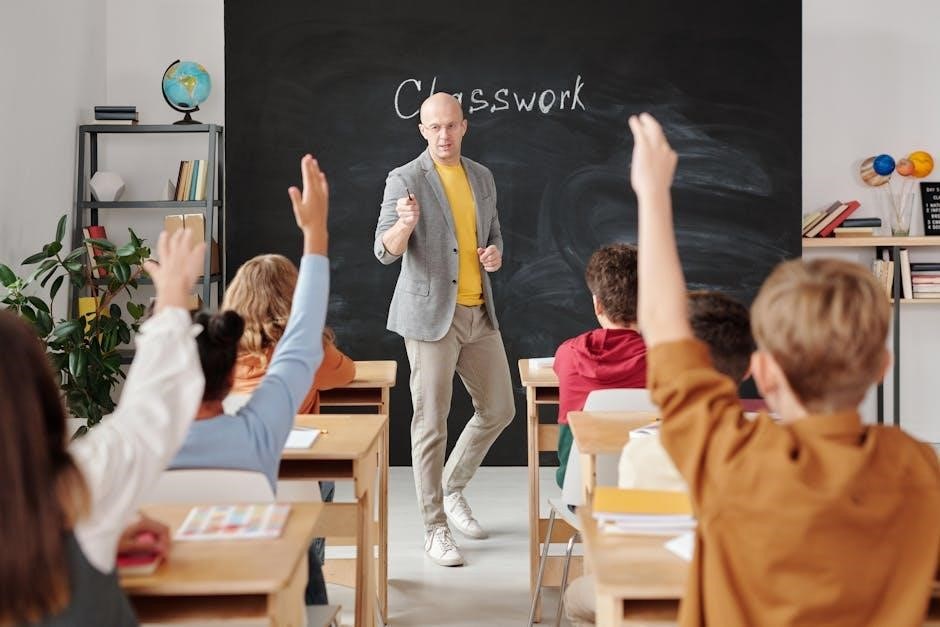Effective teaching strategies for special needs students ensure inclusive learning environments, fostering their full potential. Teachers must employ various inclusion tactics, creating a supportive and least restrictive setting.
Overview of Special Needs Education
Special needs education focuses on addressing diverse learning requirements, ensuring inclusive environments for all students. It emphasizes tailored strategies, such as differentiated instruction and Universal Design for Learning (UDL), to meet individual needs. Collaboration between general and special education teachers is crucial, fostering a supportive classroom setting. Assistive technologies and co-teaching models enhance accessibility, while individualized plans guide student progress. The goal is to create a structured yet flexible learning space where students with special needs can thrive academically and socially.

Understanding Special Needs
Special needs encompass diverse challenges, including communication, cognition, and physical disabilities, requiring tailored educational support to ensure inclusive and effective learning experiences.
Types of Special Educational Needs
Special educational needs encompass a range of challenges, including communication and interaction difficulties, cognition and learning disabilities, and social, emotional, or mental health issues. Sensory and physical disabilities also fall under this category. Each type requires tailored strategies to address individual needs effectively. Understanding these diverse challenges is crucial for developing inclusive teaching practices.
Communication and Interaction Challenges
Communication and interaction challenges often manifest as difficulties with verbal or non-verbal exchange, impacting social interactions and academic engagement. Students may struggle with understanding or using language, interpreting cues, or initiating conversations. These challenges can stem from conditions like autism or speech disorders. Effective strategies include using visual aids, structured communication tools, and speech therapy integration. Teachers should create opportunities for peer interaction and provide scaffolding to enhance communication skills, ensuring students feel supported and confident in expressing themselves. Addressing these challenges is vital for fostering inclusive and engaging learning environments.
Cognition and Learning Difficulties
Cognition and learning difficulties involve challenges with processing information, memory, attention, and understanding concepts. These difficulties can stem from conditions like dyslexia, dyscalculia, or cognitive impairments. Effective strategies include breaking tasks into smaller steps, using visual aids, and incorporating assistive technology. Teachers should provide additional processing time and use differentiated instruction to meet individual needs. Structured routines and multisensory approaches can enhance learning. Addressing these challenges requires a tailored approach, ensuring students receive the support necessary to access the curriculum and achieve their academic potential in an inclusive environment.
Social, Emotional, and Mental Health Needs
Social, emotional, and mental health challenges impact students’ ability to regulate emotions, form relationships, and behave appropriately. Teachers can use Positive Behavioral Interventions and Supports (PBIS) to create a supportive environment; Strategies include social skills training, emotional regulation techniques, and providing individualized support plans. Collaborating with mental health professionals and fostering a positive classroom culture helps address these needs. Early identification and intervention are crucial to ensure students receive the necessary support to thrive academically and socially. A proactive approach promotes resilience and well-being.
Sensory and Physical Disabilities
Students with sensory or physical disabilities require tailored strategies to access learning. Assistive technologies, such as screen readers or communication devices, empower independence. Universal Design for Learning (UDL) principles ensure materials are accessible to all. Creating sensory-friendly classrooms and providing physical accommodations, like adaptive seating, supports comfort and engagement. Collaboration with occupational therapists and specialists is essential to address specific needs. Teachers should also incorporate movement breaks and tactile activities to cater to diverse learning styles. Personalized support plans ensure each student’s unique requirements are met, fostering an inclusive and adaptive learning environment.
Assessment and Planning
Assessment and planning involve creating IEPs and using UDL to tailor instruction, ensuring students with special needs meet academic standards and receive necessary accommodations.
Individual Education Plans (IEPs)
An IEP is a legally binding document tailored to meet the unique needs of students with special needs. It outlines specific goals, accommodations, and services required to ensure academic success. Collaboration between parents, educators, and specialists is essential in developing and implementing IEPs. Regular assessments and progress monitoring are conducted to adjust strategies and ensure the student is on track to meet their objectives. IEPs promote personalized learning, fostering an inclusive and supportive educational environment that addresses the individual’s strengths, challenges, and aspirations.
Universal Design for Learning (UDL)
Universal Design for Learning (UDL) is a proactive framework that ensures all students have equal opportunities to learn by providing flexible instructional methods. It emphasizes engagement, representation, and action, offering multiple means for students to access content, participate actively, and demonstrate understanding. UDL supports diverse learning needs by incorporating assistive technologies and varied instructional strategies. This approach aligns with inclusive education principles, ensuring that all students, including those with special needs, can thrive in a supportive and adaptable learning environment tailored to their unique requirements.
Teaching Strategies and Approaches
Effective strategies for special needs students include differentiated instruction, assistive technology, and positive classroom management. These approaches promote engagement, accessibility, and personalized learning for diverse abilities and needs.
Differentiated Instruction
Differentiated instruction tailors teaching methods to meet individual student needs, ensuring all learners can access the curriculum. This approach involves modifying content, process, or product to suit diverse abilities. Strategies include learning centers, tiered assignments, and technology integration. Teachers can use small group work or one-on-one instruction to address specific needs. Incorporating assistive technology and flexible grouping also supports differentiation. By recognizing each student’s strengths and challenges, educators create an inclusive environment that fosters academic growth and engagement for students with special needs.
Co-Teaching Models
Co-teaching models involve collaboration between special and general education teachers to support inclusive classrooms. This approach promotes shared responsibility, combining expertise to meet diverse student needs. Strategies include one teaching while the other assists, or both delivering the same content. Co-teaching enhances instruction for special needs students by providing additional support and differentiated strategies. It also fosters a collaborative environment, benefiting all learners. Effective communication and planning between teachers are key to successful co-teaching, ensuring tailored support and improved academic outcomes for students.
Assistive Technology Integration
Assistive technology integration is vital for supporting special needs students, enhancing their learning experiences. Tools like text-to-speech software, speech-to-text, and interactive educational apps cater to diverse needs. Adaptive devices, such as specialized keyboards or communication aids, enable students to engage actively. These technologies promote independence, improve accessibility, and make learning more inclusive. By integrating assistive technologies, educators ensure that all students can participate meaningfully, fostering an environment where everyone can thrive and reach their full potential.

Behavioral Support and Classroom Management
Effective classroom management involves proactive strategies to support students with special needs. Techniques like clear communication, structured routines, and positive reinforcement help create a focused learning environment.
Positive Behavioral Interventions and Supports (PBIS)
Positive Behavioral Interventions and Supports (PBIS) is a proactive approach to fostering a positive classroom environment. It focuses on preventing problem behaviors by teaching alternative skills and reinforcing positive actions. By identifying triggers and implementing individualized strategies, teachers can address challenging behaviors effectively. PBIS emphasizes creating a culture of respect and inclusion, ensuring all students, including those with special needs, feel supported. This framework reduces disruptions, promotes social-emotional growth, and enhances academic engagement, ultimately benefiting both students and educators in creating a productive learning space.
Creating a Supportive Classroom Environment
A supportive classroom environment is essential for fostering inclusion and engagement among special needs students. Clear rules, structured routines, and visual supports help students with special needs stay organized. Assistive technology, such as text-to-speech tools, enhances accessibility. Teachers should also encourage collaboration and positive interactions among peers, fostering a sense of community. Adapting the physical space to meet diverse needs, like flexible seating or sensory-friendly areas, ensures all students can focus and thrive. This tailored approach promotes a culture of acceptance and empowers students to reach their full potential in a nurturing setting.

Family and Community Involvement
Active collaboration with parents and the community is vital for supporting special needs students. Engaging families in education ensures consistency and strengthens students’ academic and personal growth.
Collaboration with Parents and Guardians
Collaboration with parents and guardians is essential for supporting special needs students. Teachers should maintain regular communication through meetings, reports, and digital platforms. Sharing strategies and resources ensures consistency in learning. Involving parents in goal setting empowers them to reinforce classroom efforts at home. This partnership fosters a supportive environment, addressing academic and personal growth effectively. By working together, educators and families can create personalized plans tailored to each student’s needs, enhancing their overall development and success.
Engaging the Community in Support
Engaging the community in supporting special needs students fosters inclusive environments and enriches learning experiences. Schools can collaborate with local organizations, volunteers, and businesses to provide resources and opportunities. Community partnerships can offer mentorship programs, extracurricular activities, and access to assistive technologies. Public awareness campaigns can also promote understanding and acceptance. By involving the community, educators create a network of support that extends beyond the classroom, empowering students with special needs to thrive socially, academically, and emotionally.

Professional Development and Resources
Contemporary resources like the 12th edition of curriculum and instruction for students with disabilities provide comprehensive strategies, aiding teachers in creating successful inclusive classrooms effectively.
Ongoing Teacher Training
Ongoing teacher training is essential for effectively supporting students with special needs. Continuous professional development ensures educators stay updated on evidence-based strategies and inclusive practices. Workshops, seminars, and resources like the 12th edition of curriculum and instruction for students with disabilities provide practical insights. Teachers learn to implement differentiated instruction, co-teaching models, and assistive technology integration. Training also covers behavioral support and classroom management techniques, enabling educators to create a supportive learning environment. By enhancing their skills, teachers can better address diverse needs, fostering academic and social growth for all students, including those with special needs.
Recommended Resources and Tools
Several resources and tools are available to support teachers in implementing effective strategies for special needs students. Textbooks like Strategies for Teaching Learners with Special Needs (12th edition) and Curriculum and Instruction for Students with Disabilities provide comprehensive guidance. Online PDF guides, such as Strategies for Teaching Students with Disabilities in Inclusive Classrooms, offer practical approaches. Assistive technologies, like text-to-speech software and communication devices, enhance learning accessibility. Frameworks like Universal Design for Learning (UDL) and Positive Behavioral Interventions and Supports (PBIS) are invaluable for creating inclusive environments. These tools empower educators to address diverse needs effectively.

